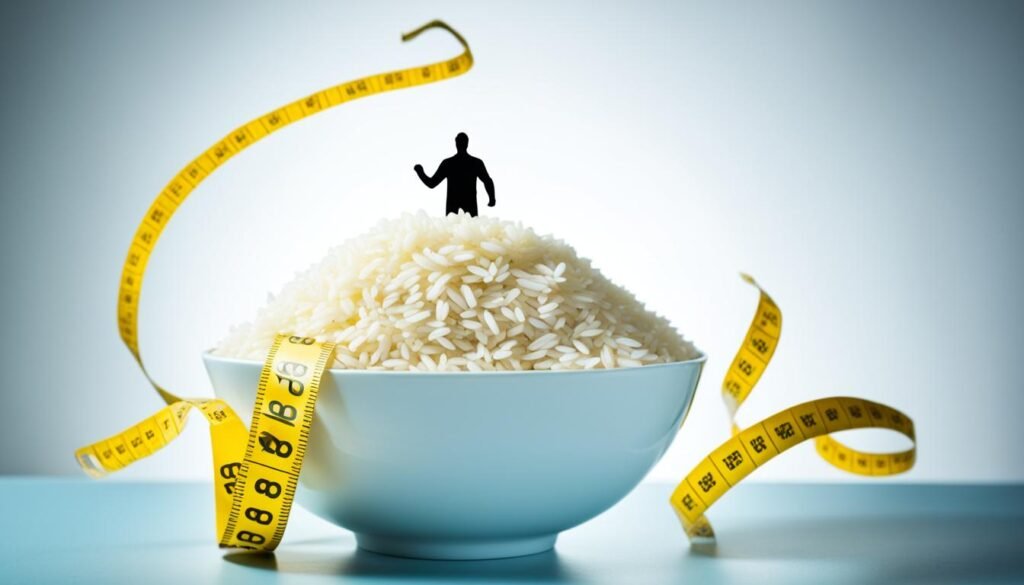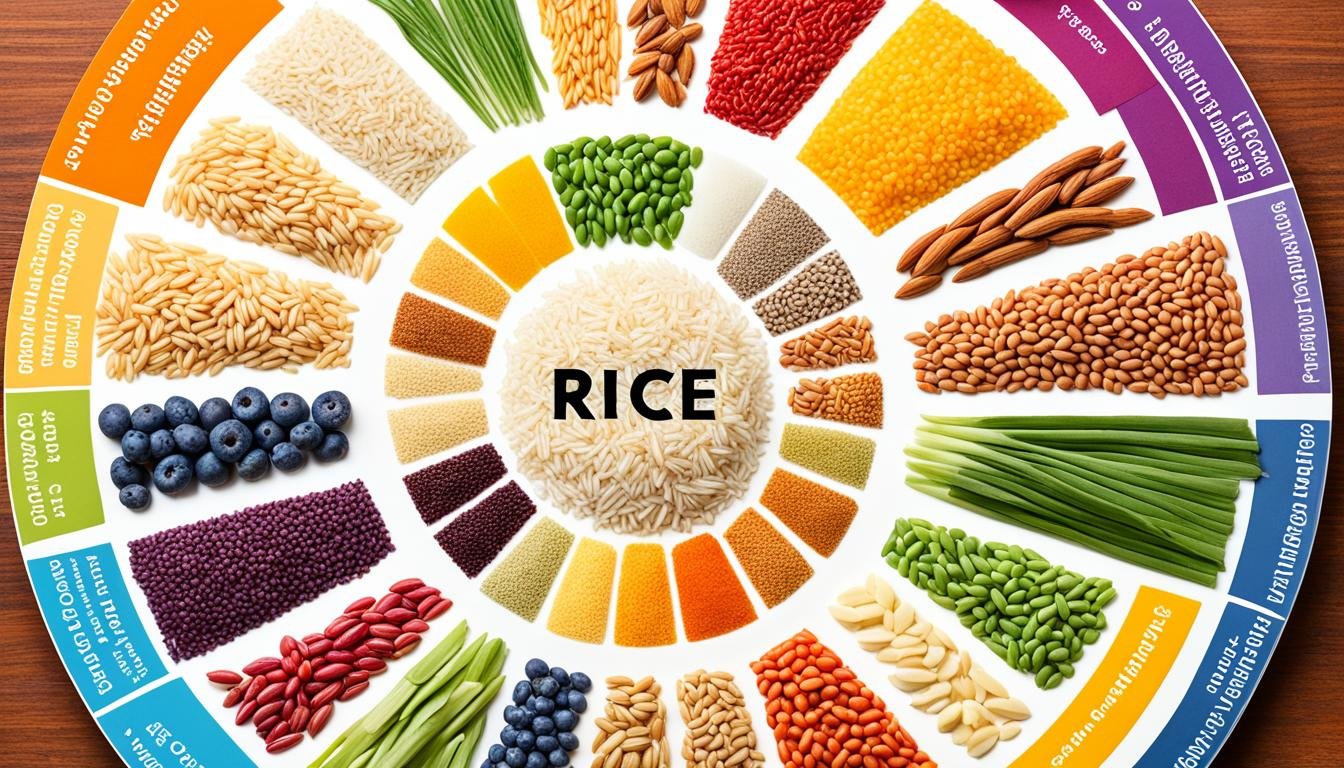Is rice healthy?
In Nigeria, my family loved eating rice. Cooking it filled our house with a wonderful smell. Seeing a plate full of light, fluffy rice always made me feel happy and reminded me of good times.
Now that I’m older, I wonder about rice’s health benefits. Is it as good for us as I thought? Or should I eat less of it? This article looks into how rice affects our health.
Rice is a very old cereal grain that many people eat. It’s a main food for over half the world’s population. Rice can be used in many dishes and fits in with different cultures.
People are still talking about whether rice is good for you or not. We want to find out the nutritional value and benefits of eating rice. We’ll talk about the nutrients in rice, like fiber. Also, we’ll look at how it affects health issues like diabetes and metabolic syndrome.
This article helps you understand if rice can help or hurt your health.
Key Takeaways
- Rice is a staple food for over half the global population, known for its versatility and inclusion in diverse cuisines.
- The nutritional profile of rice varies between white and brown varieties, with brown rice being more nutrient-dense.
- The glycemic index of rice can impact blood sugar levels, with white rice posing a higher risk for diabetes compared to brown rice.
- Rice consumption has been linked to both positive and negative effects on metabolic health, depending on the type of rice consumed.
- Rice can play a role in supporting digestive health, with different varieties offering unique benefits.
Nutritional Comparison: White Rice vs. Brown Rice
White rice and brown rice differ in how they are made. White rice has only the endosperm because the bran and germ are removed. This process takes away many nutrients. Brown rice, however, keeps the bran and germ. This makes it more nutritious.
Macronutrient Profile
White rice and brown rice have different nutrients. White rice is mostly carbohydrates, with small protein and fat amounts. Yet, brown rice has more fiber, protein, and healthy fats.
Fiber Content
Brown rice is better for you than white rice because it has more fiber. The bran in brown rice has lots of dietary fiber, which is good for the stomach and helps you feel full. White rice lacks this fiber, making it not as good for those wanting more fiber in their diet.
Vitamin and Mineral Composition
When we look at vitamins and minerals, brown rice is the winner. The bran and germ in brown rice have many essential micronutrients like B vitamins, iron, magnesium, and phosphorus. Because of this, brown rice is more nutrient-dense than white rice.
| Nutrient | White Rice | Brown Rice |
|---|---|---|
| Calories (per 100g) | 130 | 123 |
| Carbohydrates (g) | 28.7 | 25.6 |
| Protein (g) | 2.7 | 2.6 |
| Fat (g) | 0.4 | 1.0 |
| Fiber (g) | 0.4 | 1.8 |
| Vitamin B1 (mg) | 0.1 | 0.1 |
| Vitamin B6 (mg) | 0.1 | 0.2 |
| Magnesium (mg) | 25 | 79 |
| Iron (mg) | 0.8 | 0.8 |
A deep comparison shows that brown rice is better than white rice nutritionally. This includes the macronutrient profiles, fiber content, and vitamin and mineral compositions. Brown rice’s extra bran and germ mean it’s not just healthier, but also more nutritious and fibrous. This makes it a top choice for those wanting the very best rice.
The Glycemic Index and Diabetes Risk
The glycemic index (GI) tells us how foods affect blood sugar, like rice. It shows the speed carbs turn into sugar in the blood. Lower GI means sugar rises slowly.
Understanding Glycemic Index
Brown rice is an example of low GI food. It makes blood sugar rise slowly when you eat it. But, white rice has a high GI. This causes a quick blood sugar spike, which can be bad for those with diabetes.
White Rice and Increased Diabetes Risk
Studies link white rice to higher diabetes risk. Its higher GI leads to rapid blood sugar. This can cause problems like insulin resistance. However, brown rice has a lower GI and could lower diabetes risk.
Eating brown rice helps handle blood sugar and cut diabetes risk.
Knowing about the glycemic index of rice helps make better food choices. Choose brown rice over white rice for better health.
Rice and Metabolic Syndrome
Metabolic syndrome is a group of risk factors that lead to heart disease, stroke, and type 2 diabetes. These risks include high blood pressure, high sugar in the blood when fasting, high triglycerides, a large waist, and low HDL “good” cholesterol.
Defining Metabolic Syndrome
To have metabolic syndrome, you must have at least three risk factors. These include a waist of 40 inches or more for men and 35 inches or more for women. High triglycerides over 150 mg/dL, low HDL, high blood pressure (130/85 or more), and high fasting blood sugar (over 100 mg/dL).
White Rice Consumption and Metabolic Risk
Studies show eating a lot of white rice raises the risk of metabolic syndrome. The high glycemic index in white rice can cause insulin resistance. This leads to a greater chance of having metabolic risk factors.
Brown Rice and Heart Health Benefits
In contrast, eating brown rice is linked with a lower metabolic syndrome risk and better heart health. Brown rice’s more fiber and lower glycemic index help keep blood sugar, cholesterol, and weight in check. This is key for fighting cardiovascular disease and type 2 diabetes.

Is rice healthy? Impact on Weight Management
The link between rice and weight loss is often debated. Some research shows white rice might cause weight gain. This is because it has a high glycemic index and could lead to eating more calories. But, brown rice is seen as helpful for weight management in other studies.
The amount of fiber in different types of rice matters a lot. Brown rice has more fiber than white rice because it includes the nutritious bran and germ. Fiber helps you feel full and slows down how quickly your body absorbs carbs. This can help you control your weight. Also, the lower glycemic index of brown rice might keep your blood sugar steady and lower your chances of gaining weight.
| Rice Type | Fiber Content | Glycemic Index | Impact on Weight |
|---|---|---|---|
| White Rice | Low | High | May contribute to weight gain |
| Brown Rice | High | Low | May support weight management |
Studies aren’t totally clear on rice and weight loss yet. But adding brown rice to a well-balanced, controlled diet seems like a smart move for those who want to keep their weight in check. Brown rice‘s extra fiber and lower glycemic index may give you advantages in weight management over white rice.

Arsenic Contamination in Rice
Rice is a key food for many people but is now known to sometimes have arsenic. This is a big worry because arsenic can cause health problems. The ways arsenic in rice grows are complex. Consumers need to know this so they can reduce arsenic exposure from rice.
Factors Contributing to Arsenic Levels
Arsenic in rice comes from nature and people. When rice grows, it takes in arsenic from the soil and water. This is true especially in places with lots of arsenic already. How farmers water their crops, what the soil is like, and how they farm also affect arsenic levels in rice.
Mitigating Arsenic Exposure from Rice
There are steps we can take to make rice safer. Using ways of farming that don’t harm the environment and managing water well can help. Also, choosing rice types that don’t absorb as much arsenic is important. Reducing arsenic in rice even includes washing and cooking it properly.
By learning about the factors affecting arsenic in rice, we can keep our rice safer to eat. This way, rice can stay a good and healthy part of our meals.
Rice and Digestive Health
Rice is a big deal for your gut health. White and brown varieties both have their health perks. Let’s dive into how rice and digestive health go hand in hand.
White Rice for Digestive Distress
White rice for digestion is calm and comforting, especially if you’re dealing with an upset stomach. Since white rice is easier to digest, it gives your stomach a break. This helps if you have tummy troubles or are getting over a sickness.
Fiber in Brown Rice for Gut Health
Brown rice’s big plus is brown rice fiber for gut health. Thanks to its bran and germ, it’s packed with fiber. This helps you stay regular and keeps your gut in good shape. The fiber also feeds the good bacteria in your stomach, which is key for a happy gut.
| Digestive Health Benefit | White Rice | Brown Rice |
|---|---|---|
| Digestibility | High | Moderate |
| Fiber Content | Low | High |
| Impact on Gut Microbiome | Neutral | Positive |
| Suitability for Digestive Distress | Suitable | Suitable with Moderation |
When choosing rice for your health, it depends on what you need and like. Mixing white and brown rice in your diet is a good way to get various health benefits.
Antinutrients and Other Concerns
Rice is generally a safe and healthy food. However, it’s good to know about rice antinutrients and heavy metals. These issues can affect rice’s health benefits.
Phytic Acid in Rice
Like other whole grains, rice has phytic acid, which is an antinutrient. Phytic acid can lessen the body’s absorption of iron, zinc, and calcium. This matters a lot for those who lack these minerals or eat mostly plants.
It’s really important for them to be aware of phytic acid’s effects.
Heavy Metal Accumulation
There’s also a worry about rice collecting heavy metals like arsenic, cadmium, and lead. These metals can be harmful, especially if you eat a lot of rice. The levels of heavy metals in rice can come from the soil, how it’s watered, and its processing.
| Concern | Explanation | Mitigation Strategies |
|---|---|---|
| Phytic Acid | It can latch onto important minerals, making them harder to absorb. | If you soak, sprout, or ferment rice, you can lessen phytic acid’s effects. |
| Heavy Metals | Rice can gather metals that are unsafe, such as arsenic and cadmium. | To reduce your risk, choose rice grown in clean areas. Plus, wash and cook it well. |
Knowing about these issues and taking steps to reduce them allows us to keep enjoying rice’s benefits. It can still be part of a nutritious eating plan.
Conclusion
Rice is a common food that many people enjoy eating. It can be healthy to eat if you include it as part of a varied diet. While brown rice is more nutritious, white rice is still good for some people.
Eating a mix of white and brown rice, along with other nutrient-rich foods, is key. This mix helps you get different nutrients. Plus, it makes sure you don’t miss important vitamins and minerals for your health.
A balanced diet doesn’t mean cutting out foods you love. It’s about finding the right mix for your health. So, keep enjoying rice. Just make sure to also eat plenty of other whole, natural foods. This way, you can stay healthy and happy.






